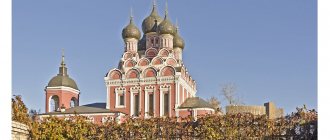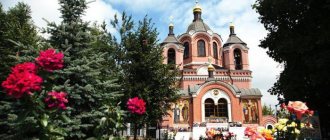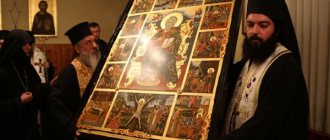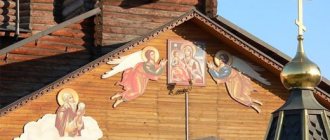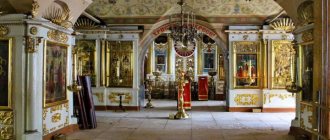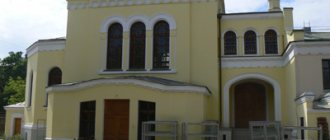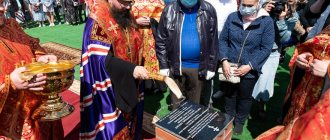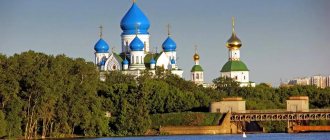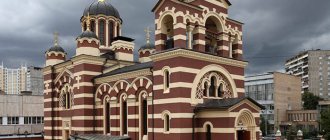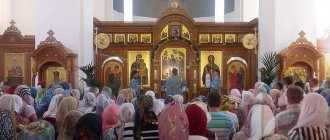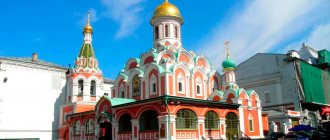Website: tihvinskiy.ru
Postal address: 129366, Moscow, prosp. Mira, 130.
Art. metro: VDNKh.
Telephone.
View the schedule of services
How to get there by public transport: metro station "VDNKh", exit from the last car from the center. 2 minutes. Walk to the temple.
Throne: Tikhvin Icon of the Mother of God (July 9). Chapels: St. Sergius of Radonezh (July 18, October 8, Cathedral of Moscow Saints), St. Nicholas the Wonderworker (May 22, December 19), St. Alexy, man of God (March 30), martyr. Tryphon (February 14).
Shrines
- the miraculous Tikhvin Icon of the Mother of God of Byzantine writing (celebration - July 9);
- an exact copy of the Cave of the Holy Sepulcher;
- image of the Mother of God “Addition of Mind” (celebration - August 28);
- reliquary from St. relics on the throne of the main altar.
Story
Initially, on the site of the temple there was the Kopytovo estate, which belonged to Prince Dmitry Trubetskoy, and later to his widow Anna Vasilyevna Trubetskoy. The estate was located on the ancient Trinity Road leading from Moscow to the Trinity-Sergius Lavra. Not far away were Sokolniki, a pine forest in which Tsar Alexei Mikhailovich preferred to hunt.
Once, the king, who stopped to rest in Kopytovo, liked this place so much that he wished to have a travel palace here.
In the middle of the 17th century. A wooden palace was built, and later Trubetskoy erected the stone Alekseevsky Church here, named in honor of the patron saint of the reigning person. The church gave a new name to the village itself, which from that time began to be called Alekseevsky.
When Trubetskoy died in 1655, the estate came under the control of the Palace Prikaz, which was in charge of state (royal) affairs, including land property.
The Tikhvin Temple in Alekseevsky began to be built in 1673 by decree of Tsar Alexei Mikhailovich. At the same time, the Alekseevskaya Church was renewed. Both temples and the travel palace were connected by covered galleries and formed a single complex.
Alexei Mikhailovich himself did not have a chance to see the completion of the construction of the church, since he died in 1676. The consecration of the temple was carried out 4 years later. The consecration was carried out by the Patriarch, in whose presence the new sovereign Fyodor Alekseevich granted the church servants a miraculous copy of the Tikhvin icon.
A further milestone in the fate of the temple was the events of the Napoleonic Wars. The complex was seriously damaged during the Patriotic War of 1812. French troops used the premises as a warehouse and stables. No later than 1817, the travel palace was dismantled, reaching a state of extreme disrepair.
In 1824, the Alekseevskaya Church was also dismantled, the bricks from the dismantling of which were later used for the construction of the bell tower.
At the same time, restoration of the temple was carried out. For the first time, its walls were decorated with frescoes. In the middle of the 19th century. two side altars were built (St. Nicholas and St. Sergius). The restoration was carried out both with funds from the Treasury and merchant donations. Later, in 1890, in memory of the dismantled Alekseevskaya Church, a chapel was built in the temple in the name of Alexy, the Man of God.
At the same time, a cemetery of the same name was established next to the temple. Just before the October Putsch, symmetrically to the chapel of St. Alexy, a chapel was created in the name of the Martyr Tryphon. The Tikhvin Church retained its status even after the October Revolution. Despite the persecution of believers and the confiscation of church valuables, it did not close its doors to parishioners for a single day.
Even the bells on the bell tower were preserved, but they never rang under Soviet rule. The Soviet government left the main space of the temple to the Russian Orthodox Church. But other premises were transferred to the needs of the new government. In the basement, where shortly before the revolution the chapel of the Resurrection of the Word was built, a vegetable storage facility was equipped.
Later, part of the premises of the lower church was given over to art workshops, the other to the candle factory of the Patriarchate. After the fall of the USSR, all premises were returned to the church.
History[edit]
In the 17th and 18th centuries, Sushchevskaya Street was the main route of the Sushchevskaya Sloboda, and the church was the main temple of this settlement. The primacy of the temple is also confirmed by the engraving of the Dutch traveler K. de Bruon. In the engraving, the traveler depicted Moscow in 1702, where the temple with the bell tower in Sushchev is clearly visible. (On the recommendation of Peter I, C. de Bruon painted Moscow from the Sparrow Hills). In 1710, a chapel was added to the north side of the temple in honor of St. Apostle Andrew the First-Called.
Since the end of the 18th century, the huge estates between Bankovsky Lane and Kamer-Kollezhsky Val (now Suschevsky) belonged to the widow of the Actual Privy Councilor Nadezhda Vasilyevna Shepeleva. On the territory of the estate, located next to the Church of the Tikhvin Icon of the Mother of God, there was a huge shady park consisting of various tree species. There was also a pond there, which was called Vasilievsky, in memory of the holy fool St. Basil the Blessed, who loved to retire to this park. Being a parishioner of the Church of the Tikhvin Icon of the Mother of God in Sushchev, N.V. Shepeleva “generously endowed her parish Tikhvin church with rich contributions.” Until 1812, the property of N.V. Shepeleva and the surrounding area was called New Sushchev and consisted of country houses of noble families: princes Vadkovsky, Skavronsky, Lyapunov, Tolstoy, etc.
During the Patriotic War of 1812, two-thirds of the city's buildings were destroyed by fire. “Emperor Napoleon, having ordered the burning of Moscow, committed a barbaric act...” During the enemy's stay, the churches of Moscow were plundered, destroyed and desecrated. The disasters of the war did not even pass by the Tikhvin Church in Sushchev: “Our designated church with the chapel of the Apostle Andrew the First-Called was robbed by the enemies of faith and humanity and deprived of its splendor. The Holy Sees are devastated." The main chapel of the church in the name of the Tikhvin Icon of the Mother of God was very badly damaged and only the chapel church in the name of St. Andrew the First-Called Apostle was prepared for the celebration of the priesthood, “but as parishioners and willing donors helped, the chapel church was restored, and everything necessary was prepared for the celebration of the priesthood.” On December 5, 1812, the chapel in the name of the Holy Apostle Andrew the First-Called was consecrated anew, as priest Timofey Ioannov reported in his “Report” to the “Tikhvin Church of the Most Holy Theotokos in Sushchev.”
It is noteworthy that after the Patriotic War of 1812, it was decided that out of 257 churches that survived the fire, only 157 should be preserved, and the rest, due to the complexity of repairs, should be dismantled, but Muscovites did not allow dismantling and restored the churches at their own expense. By 1817, there were already 246 churches in Moscow. After 1812, the area near the Church of the Tikhvin Icon of the Mother of God changed: it began to be populated by artisans, gardeners - future parishioners who settled in poor houses. But there were still few buildings and the area near the temple was replete with groves. “To the northeast, near the parish of the Tikhvin Church, the pine Maryina Grove began and was lost in the distance like a dark wide ribbon, then not yet inhabited by anyone - a favorite place for promenades of poor Muscovites, and in the southeast there was a “wasteland through which the shining Moscow was clearly visible.” with your wide eyes."
In the summer of 1820, the Church of the Tikhvin Icon of the Mother of God with the chapel of St. Andrew the First-Called Apostle at the expense of N.V. Shepeleva “was restored from the outside in the best possible way, but the bell tower located next to it remained without amendment and was completely inappropriate for the splendor of the church.” In 1825, through the efforts of a wealthy parishioner, a new bell tower was erected. In the same years, at the expense of N.V. Shepeleva, a carved gilded iconostasis was made and holy images were painted for the iconostasis. Inside, the walls were decorated with writings. She also “donated priestly and deacon’s vestments, embroidered on velvet with gold and pearls, and similar coverings for sacred vessels.” The temple was completely restored and updated. And in 1850, on the southern side of the temple, symmetrically to the northern aisle, a chapel was built in the name of the icon of the Mother of God “Joy of All Who Sorrow,” also at the expense of N.V. Shepeleva.
By the middle of the 19th century, the Church of the Tikhvin Icon of the Mother of God, inside and out, was completely renewed and expanded thanks to significant donations from N.V. Shepeleva. The church now has three chapels: the main one in the name of the Tikhvin Icon of the Mother of God and the northern chapel in the name of St. Apostle. Andrew the First-Called, southern - in the name of the icon “Joy of All Who Sorrow.”
After the death of N.V. Shepeleva (1761-1854), her possessions passed to the princes Golitsyn, and in 1900, all possessions according to the will of A.V. Golitsyna were transferred to the monastery “Joy of All Who Sorrow,” founded by her in 1890. (Now in front of “Stankin” on Novoslobodskaya Street there is a headless Church of the All-Merciful Savior, the only one surviving from the monastery).
From time immemorial, the Tikhvin Church was surrounded by special human care: it was expanded, renovated, and landscaped. In 1896, the walls decorated with paintings in the main chapel of the temple were renewed, in 1900 the iconostasis in the same chapel was restored... and already at this time it was planned to enlarge the temple, as the number of parishioners grew. The Sushchevo area is being intensively built up. Along with permanent residents, many teams of contractors live in the area, who visit the temple on holidays. In this regard, at the beginning of 1901, “The clergyman, the elder and the parishioners ask to be allowed to expand the said church and move the altars to new places” since on holidays The temple is extremely crowded." Permission was received from the Moscow Spiritual Consistory. And already in October 1902, work on the expansion of the temple was completed, as stated in the “Act of October 15. 1902" Cool Artist Dmitry Vinogradov. The church was completely rebuilt according to the design of S. Yakovlev at the expense of the church, parishioners and willing donors, as local priest S. Solovyov reported to the Dean in his “Report”. The temple was significantly enlarged. The throne in the name of the icon of the Mother of God “Joy of All Who Sorrow” was consecrated on October 25, 1902, on the eve of the feast commemorated on October 24. Throne in the name of St. Apostle. Andrew the First-Called - consecrated on November 29, 1902, on the eve of the celebration of his memory, which is celebrated on November 30. The consecration was performed by the dean archpriest Nikolai Fedorovich Voznesensky.
In 1905, two more chapels were built inside the temple at the expense of parishioners Nikita Nikolaevich Korolkov and Mikhail Ivanovich Nikiforov; in the name of St. Theodosius of Chernigov and in the name of St. Seraphim of Sarov. The thrones were consecrated by the dean archpriest N.F. Voznesensky on July 19, 1905 - “on this day Orthodox Russia celebrated a rare spiritual triumph - the glorification of St. Seraphim of Sarov ascetic” 70 years after his death. (On this day the discovery of the multi-healing relics of the Venerable Father Seraphim took place and he was canonized). For the two newly built chapels, the painter Kulakov painted icons of St. Theodosius of Chernigov and St. Seraphim of Sarov, and master Stazharova made silver vestments for these icons.
Since that time, in the church of the Tikhvin Icon of the Mother of God there are five altars: the main one - in the name of the Tikhvin Icon of the Mother of God and the side altars - in the name of the Holy Apostle Andrew the First-Called, in the name of the icon of the Mother of God "Joy of All Who Sorrow", in the name of St. Theodosius of Chernigov, in the name of the Venerable Seraphim of Sarov. There were seven bells on the temple bell tower. The largest holiday bell weighed 342 pounds, the polyley bell weighed 100 pounds, and the remaining five bells weighed less. A distinctive feature of Russian bells is their sonority and melodiousness, and one can only imagine the majestic sound of these powerful seven bells.
Over the following years, until 1917, the temple was constantly renovated and improved through the efforts of the church and parishioners: the vaults of the refectory part of the temple were redone, the mosaic floor was repaired, the painter Kulakov made a 2nd tier of the newly built side-side iconostases, the painter Filippov painted the walls above the icon of God Mother of “Joy of All Who Sorrow” and above the icon of St. Apostle. St. Andrew the First-Called in the newly built side aisles; The temple frescoes in the main chapel were renewed and washed, the chandelier was gilded... The temple courtyard was paved. The temple had a large library, which was replenished annually with subscription editions of spiritual literature. The temple subscribed to magazines and newspapers such as “Trinity Leaflet”, “Russian Pilgrim”, “Wanderer”, “Soulful Reading”, etc.
But 1917 came. After the revolution, persecution of the Church began: churches are taken away from believers and used for warehouses, factories, clubs, garages, or simply demolished - ancient monuments are destroyed, and “The Monument,” said Metropolitan Philaret, “is a silent preacher, who in some respects can be superior to the speaker, because he does not stop preaching entrusted to him, and thus reaches the whole people and many subsequent generations.”
Bells from the bell towers of surviving churches are being thrown down and sent to be melted down - it seemed that the voices of hundreds of Moscow churches had been silenced forever. Clergymen are persecuted: in 1919 alone, 66 high clergy were imprisoned or exiled: 6 Metropolitans, 3 Archbishops, 57 Bishops. 59 relics were opened - there was a mockery of the Church.
In 1922, according to the “Resolution of the All-Russian Central Executive Committee” dated February 22, 2022, church valuables were confiscated from surviving churches and monasteries. Highly artistic church utensils made of precious metals, created by people over centuries, are mercilessly destroyed - everything is transported in trains to the West for sale as scrap metal. Thus, in a telegram dated August 22, 1922, it is reported that in the windows of Riga “a significant number of church valuables brought from Russia appeared, among them noteworthy: miter with diamonds, pectoral crosses, ancient icons, church vestments in an open form”... According to the “Act of April 5, 1922,” 11 pounds 26 pounds 54 spools of silver items were confiscated from the Church of the Tikhvin Icon of the Mother of God. The parishioners of the Church of the Tikhvin Icon of the Mother of God, in a Statement dated April 5, 1922, asked to return (taken during the seizure of valuables on April 5) two ancient Gospels of the 18th century and one chasuble from the Tikhvin Icon of the Mother of God as revered by all parishioners...” Of course, nothing was returned. None of those who carried out the confiscation of church valuables were interested in ancient icons by old masters or the artistic value of the objects. There was only one goal - to confiscate gold, silver, and jewelry. Maybe this saved the icon of the Tikhvin Mother of God, which has now returned to its church in Sushchev (without the robe, of course).
The archives have preserved documents that describe the splendor of the Tikhvin Icon of the Mother of God in the church in Sushchev before the destruction to which it was subjected on April 5, 1922: “Temple icon of the Tikhvin Mother of God of Greek writing, on it: 1. A gilded silver chasuble with a crown, weighing twenty-five pounds and six spools. On this robe, the lamb is decorated with many simple and small stones and several equally large ones. 2. The ubrus in the picture is made of pearls, in it there are large pearls of eight hundred grains, weighing thirty-four spools, - medium three hundred eighty-seven grains, weighing nine spools, - small ones - three and a half spools. Between these pearls are set: a) on the upper part of the lining there are three gold rings: the first ring of them has a turquoise stone in the middle, surrounded by diamonds, of which there are twenty-one; the second is decorated with thirty-seven diamonds, in the middle of which is an emerald stone; the third is decorated with a scattering of roses and sixteen diamonds, in the middle of which is a venus stone; b) on the sides there are six medium-sized silver cufflinks: three of them are decorated with twenty-five diamonds, three with yakhonts, two of the last have one emerald; c) at the bottom there are small cufflinks, each with seven diamonds.”
In the 50s, surviving churches and monasteries began to close. This bitter fate will not escape the Church of the Tikhvin Icon of the Mother of God. On January 25, 1955, “Resolution No. 73” was issued by President. Moscow Regional Executive Committee “on the closure of the Church of the Tikhvin Icon of the Mother of God in Sushchev. And on January 31, the council of the “Orthodox Christian Community of the Tikhvin Church in Sushchev” appealed to the cult commission of the All-Russian Central Executive Committee - the parishioners still hope to return their temple. The “Petition” indicated that the church serves a very large area: from the Lazarevsky cemetery to Bashilovka and from Alexander Square to the Vindavskaya railway line (now Rizhskaya); it was also indicated that “the temple is visited by believers who were previously served by churches: the former Sorrow Monastery, b. Kazanskoy, b. Miusskoe cemetery, b. Lazarevsky cemetery, etc. (By this time, many surviving churches and monasteries were desecrated or “liquidated”).
Despite convincing requests from parishioners, on April 5, 1955, the Presidium of the All-Russian Central Executive Committee decided to “liquidate the Church in Tikhvinsky Lane.” The temple is closed and given to the Machine Tool Institute (Stankin) for mechanical workshops. Stankin is rebuilding the temple to meet the needs of a training and experimental plant. For this purpose, three additional floors were made inside the temple up to the octagon, second floors were made in the southern and northern aisles, and the resulting first floor was redesigned - a series of ridiculous partitions were made. The altars were desecrated - an iron foundry was set up in them, and therefore the soil in the altars was saturated with fuel oil to a depth of 2 meters, the walls were also damaged and were partially destroyed. The magnificent wall paintings were mercilessly destroyed. Outside, buildings were attached to the temple building, and in the temple courtyard there was a pile of various types of sheds, which turned the area into a huge dump.
Since 1984, the Church of the Tikhvin Icon of the Mother of God in Sushchev is listed under No. 557 as an architectural monument and is under state protection, but no measures have been taken over the years to preserve the temple.
In 1991, the surviving churches were returned to the Moscow Patriarchate, therefore, by the Decree of His Holiness the Patriarch of July 5, 1991, the archpriest of the Church of St. Pimen Eremin Vladimir Vasilyevich was appointed rector of the surviving but desecrated Church of the Tikhvin Icon of the Mother of God, in Sushchev, with the continuation of service in the Church of St. Pimen the Great. But only a year later, on May 26, 1992, by order of the Moscow Government, the Church of the Tikhvin Icon of the Mother of God was returned. The returned temple was so destroyed and wounded that it made a painful impression. But it was necessary to revive the temple. Stankin was in no hurry to remove his bulky equipment, of which there were more than 200 units, so the first all-night vigil and prayer service on the feast of the Tikhvin Icon of the Mother of God on July 9, 1992 were held in a small space cleared of machines. From this day on, church and parish life is resumed; On Saturday evenings and on the eve of holidays, all-night vigils began to be held, and on major holidays, prayer services were held in the mornings: the rest of the time, work was carried out with our own small forces to clear the territory: from the desecrated main altar of the temple, pungent, odorous soil was manually removed, the removal of which required more than 30 cars.
The only chapel that could be prepared for the Divine Service in a short time was the chapel in the name of the Mother of God “Joy of All Who Sorrow,” but it was still filled with equipment. Finally, in October, Stankin took out the equipment, and a month later, on December 5, 1992, a small consecration of the chapel in the name of the Mother of God of All Who Sorrow was carried out by Dean Archpriest Vladimir Divakov; On the same day the all-night vigil was celebrated. To the great joy of the parishioners, on December 4, on the day of the feast of the Entry of the Blessed Virgin Mary into the Temple, the first Divine Liturgy was celebrated. After almost 60 years of desecration, regular divine services have been resumed in the church: the Word of God is heard again, prayers are offered, lamps are lit in front of the holy icons - the church is being spiritually reborn.
On July 8, 1993, on the eve of the feast of the Tikhvin Icon of the Mother of God, the temple icon of the Tikhvin Mother of God, which had been in the church of St. Pimen since 1935 after the closure of the church in Sushchev, was returned. It is amazing that this icon is the ancient icon painted for this temple, which miraculously survived and returned to its destroyed temple after 60 years. On the feast of the Tikhvin Icon of the Mother of God on July 9, the first Divine Liturgy was celebrated before the returned temple icon. The image of the Tikhvin Mother of God, now in our church, revered since ancient times, is touching in that it resembles the Miraculous Image of the Mother of God, “who deigned to appear in 1383 to fishermen over the water without earthly ornaments, which were later brought as a gift by the zeal of Christians.”
After some time, the temple was replenished with several large ancient icons transferred from the temple of St. Pimen; These are icons: St. Nicholas, St. Seraphim of Sarov, St. Blessed Prince. Alexander Nevsky, Holy Great Martyr George the Victorious. With these icons, the replenishment of the church began with large and small images that came from parishioners and well-wishers-patrons.
In 1999, particles of the relics of the 12 Elders of Optina were brought from Optina Pustyn (at our request), and in 2000, the rector of the Temple, Archpriest Vladimir Eremin, brought a particle of the relics of Archpriest Theodosius. Chernigov, whose imperishable relics are located in the Holy Trinity Cathedral in Chernigov.
Due to meager funding or its absence at all, restoration and reconstruction work on the external appearance of the temple is proceeding extremely slowly - the temple is huge - more than 800 square meters. m and without government funding, its restoration will take years. Inside the temple, work is carried out on our own and at the expense of parishioners and voluntary donors. At the end of February, with the help of philanthropists, the restoration of the central chapel of the temple and the chapel in the name of the Apostle Andrew the First-Called was completed.
And on March 2, 2002, to the great joy of the parishioners, a small illumination of the central altar and altar was carried out by the rector of the Great Ascension Church, Head. by the office of the Patriarchate, Archpriest Vladimir Divakov.
Despite the destruction of the external appearance of the temple, the grace of God is inherent in this holy place - the temple lives: services are held, bells ring, the choir sings.
Architecture and appearance
History has not conveyed to this day the exact name of the architect who became the author of the temple project. According to some researchers, the architect who built the temple was the architect Fyodor Tikhonov (Tikhanov), who was the author of several other Moscow churches of the second half of the 17th century.
The external appearance of the temple is made in the typical Russian (Moscow) pattern style of its time, which became most widespread during the reign of Alexei Mikhailovich. This architectural style is characterized by an abundance of external decor, the use of floral patterns in interior decoration, the complexity of the composition and unusual forms.
It is no coincidence that the Mannerist style is considered a distant analogue of Russian patterning in Western European architecture. The Tikhvin Church in Alekseevsky can be called an example of this architectural style. It is based on a pillarless five-domed temple, classic for Russian architecture, installed on a high basement.
The upper part of the main volume of the building is decorated with 3 rows of kokoshniks, topped with 5 domes. The palette of the external walls is designed in a classic combination of red and white colors for the architectural style. At the bottom of the temple there is a bypass gallery, on the western side there is a refectory, which once served as a transition from the church building to the Travel Palace.
Also located on the west is a bell tower, built in the first half of the 19th century. from bricks of the dismantled Alekseevsky Church. The architecture and interior decoration of the bell tower are made in the style of the 19th century, so it somewhat contrasts with the appearance of the temple, although the red and white color palette is also observed.
Interior decoration
First of all, the size of the temple attracts attention. From the entrance to the high place there are 37 m. The main altar of the temple is also unusually large. Also impressive are the two rows of windows, made in the best traditions of the Byzantine style.
The peculiarity of the internal composition of the cathedral is determined by its status. It was built as a temple for the king making a pilgrimage to the Trinity-Sergius Lavra, therefore, for the convenience of the royal couple, separate closed rooms were allocated inside. They were separate chapels for the king and queen, separated from the other public.
Tikhvin Church of the Icon of the Mother of God, interior decoration.
The original decor has been preserved in the royal chapel. It is decorated with an authentic tiled stove and wooden candlesticks made during the construction of the temple. Otherwise, the interior space of the church corresponds to the classical Orthodox tradition.
The original decoration of the middle part of the temple has not survived to this day. The current wall paintings were made at the beginning of the 19th century. a team of craftsmen led by the painter Ivan Karlovich Scotti. The frescoes depict events from the Old and New Testaments, the life of St. Nicholas the Wonderworker and St. Sergius of Radonezh.
The main five-tiered iconostasis has been preserved since the construction of the temple; the center of its composition is the miraculous copy of the Tikhvin Icon of the Mother of God, covered with a special canopy.
In addition to the main altar, 4 chapels are consecrated in the main space of the temple:
- a chapel in the name of Venerable St., transferred from the dismantled Alekseevsky Church. Alexia;
- in the name of Rev. Sergius of Radonezh;
- in the name of St. Nicholas the Wonderworker;
- in the name of the martyr Tryphon of Apamea.
Also in the basement is the chapel of the Resurrection of the Word, which housed art workshops until 1998.
Activities of the parish
The parish of the Church of Our Lady of Tikhvin carries out active social work. Thus, the temple servants developed the “Common Cause” project, aimed at reviving the wooden temple architecture of the Russian North.
Divine Liturgy in the Church of the Tikhvin Icon of the Mother of God
Social service is carried out:
- in places of deprivation of liberty;
- in orphanages and orphanages;
- in hospitals and nursing homes.
During the holidays, church volunteers conduct children's camps, organize concerts and theatrical performances.
Attention! Due to active social activities, the temple is constantly in need of volunteers who are ready to help those who need help free of charge.
Shrines
The main shrine of the church is the miraculous copy of the Tikhvin icon. In the Orthodox tradition, a list is a reproduction of a particularly revered icon, which does not necessarily exactly copy the original in form, but has the same content. Many lists are equal in their miraculous power to the original.
The list of the Tikhvin icon belongs to Byzantine writing, that is, made in the traditions of Byzantine iconography. It was filmed in the middle of the 17th century. directly from the Tikhvin icon itself, now kept in the Tikhvin Mother of God Assumption Monastery. The Tikhvin image of the Mother of God is not the only venerable shrine of the temple.
Objects of special veneration are:
- a copy of the Holy Sepulcher (left choir) - a reproduction of the main shrine of Christianity, the tomb in which Jesus Christ was buried after the crucifixion;
- the image of the Mother of God “Addition of Mind” (right choir) - an icon to which people turn for deliverance from mental illness, help in studying, enlightenment of the mind;
- the icon of the Mother of God “Watching Eye” - a unique image for Orthodoxy of the Mother of God with Christ, depicted at a young age;
- a cross with the relics of Nicholas the Wonderworker, historically the most revered saint in Rus';
- the image of St. Alexis (possibly transferred from the lost Alexeevskaya Church);
- reliquary with the relics of saints.
The Tikhvin Church is also the storage place for several dozen revered icons that were previously kept in the Alekseevskaya Church. Among them we can note the images of Our Lady of Kazan, Our Lady of Kozelshchanskaya, Our Lady of Help in Childbirth.
Patronal holidays
Every year on July 9th the patronal feast day of the Tikhvin parish is celebrated. On this day, in simple words, the birthday of the church in Alekseevskoye and the day of veneration of the Tikhvin Mother of God icon are celebrated. According to tradition, the holiday begins with the Liturgy and several sermons. The service ends with a religious procession with the icon of the Tikhvin Mother of God and spiritual singing, however, the holiday does not end there.
Patronal feast day of the Church of the Tikhvin Icon of the Mother of God in Alekseevsky
In the courtyard of the temple, ministers arrange a common lunch for all parishioners, during which you can enjoy the taste of simple Russian dishes and share with all the diners the joy that fills the heart of everyone who came that day to listen to the priest’s instructions, or simply to pray at the holy icon.
Interesting facts and legends
There are many interesting facts and legends associated with the ancient temple, which allow us to understand its important role not only in Orthodoxy, but also in the history of the city and country.
They are:
- The very appearance of the Tikhvin icon in Rus' is unusual: previously it was kept in Byzantium, but with the fall of the latter, it was discovered floating above Lake Ladoga;
- the tiled stove in the royal chapel can be called a prototype of oven heating (the firebox was located in the basement, from where hot air entered the room through a system of internal passages);
- according to legend, during the next unrest of the Streltsy in 1689, Emperor Peter I found temporary shelter in the temple, where a delegation of Streltsy confessed to him. Peter forgave those who appeared, unlike the unrepentant rebels, who were later put on trial and executed;
- the author of the Sergius and Nicholas thrones was the outstanding Russian architect Mikhail Bykhovsky, who led the restoration of the temple in the 19th century;
- during the seizure of church valuables in 1922, 114 kg of silver items and 58 diamonds were requisitioned;
- the upper church was not closed even in Soviet times, but the winter Church of the Resurrection of the Word, located in the basement, was not so lucky - initially it was a vegetable storehouse, then art workshops and a candle factory of the Patriarchate;
- according to legend, on the personal instructions of Stalin, a miraculous image of the Tikhvin Mother of God, kept in the temple, was flown over the city in order to protect Moscow from the Germans in the most dangerous days of the winter of 1941;
- the previous Patriarch of the Russian Orthodox Church, Alexy II, since 1962, annually on March 30, held a liturgy in the church on the name day of St. Alexy, the patriarch often held services on July 9, the day of remembrance of the Tikhvin Icon;
- 19th century frescoes were discovered during restoration work carried out in the 70-80s. XX century, until that moment they were covered with later wall paintings.
During the years of Soviet power, the Church of the Tikhvin Icon of the Mother of God in Alekseevsky was never closed
In Soviet times, despite the fact that there was persecution of Orthodoxy in the country, the temple was never closed. This is due to the historical value that it represents.
In addition, the unique architecture of the church adorned the view of the capital, which served as additional “protection” for it.
A fragment of the fence of the Church of the Icon of the Mother of God of Tikhvin in Alekseevsky, Moscow. During all the years of Soviet power, the temple was not closed. Moreover, it was built and decorated, so at the beginning of the 20th century a parable house and a church fence were built
Church life was carried on in the temple all the time, and it was even expanded and decorated. So in November 1917, in symmetry with the Alekseevsky chapel, under the northern end of the temple, the chapel of the martyr Tryphon was created. In 1922, the Church of the Resurrection of the Word was built in the basement of the temple.
The iconostasis for it was taken from the house church of one of the Muscovites; the name was chosen in memory of the Church of the Resurrection in Rostokin, which existed in the 16th - 18th centuries. In addition, a parable house and church fence were built at the beginning of the 20th century.
The Soviet authorities were unable to close the Church of the Tikhvin Icon of the Mother of God in Alekseevsky.
Despite the fact that, by God’s Will, the Soviet authorities did not close the temple, on April 23, 1922, they removed 6 pounds 32 pounds 95 spools of silver (114 kg) and 58 diamonds from it. Valuables were recovered from church utensils and liturgical objects.
In addition, the lower church was also taken away from the parish in order to set up a vegetable base in it. Later, the workshops of the Sofrino Art and Production Enterprise were located here, which were located there until 1998.
Church of the Icon of the Mother of God of Tikhvin in Alekseevsky, Moscow. 1974-1976. Despite the fact that the authorities did not close the temple, they did not provide him with any assistance. So there was a ban on bell ringing, and the trees growing next to it were not pruned
It is worth noting that the bells were never removed from the bell tower, but they did not ring for a long time. The area around the church was left without maintenance, and overgrown trees hid it from view.
God's Providence can also be seen in the fact that the temple miraculously survived during the great Stalinist construction of VDNKh. The fact is that the authorities could consider that it spoils the view of VDNKh and decide to demolish it. Fortunately, this did not happen.
Opening hours and schedule of services
The Tikhvin Church is open to visitors and parishioners daily from 07:00 to 19:00.
Schedule of services:
- on weekdays and Saturdays - 08:00 (liturgy) and 17:00 (vespers or all-night vigil);
- on Sundays and church holidays - 07:00 (early liturgy), 10:00 (late liturgy); 17:00 (all-night vigil or vespers).
On Fridays from 19:00 there is a conversation about the Sacrament of Baptism with people who are preparing to take an important step on the path to salvation of the soul. Every last Saturday, a prayer service is served for pregnant women in front of the revered icon of the Mother of God “Helper in Childbirth.”
How to get there
The Tikhvin Church in Alekseevsky is located in the north-east of the capital near the VDNH metro station of the Kaluzhsko-Rizhskaya (orange) line of the capital's metro. The southern exit from the station lobby is located near the small park “Road to the Temple”, on the outskirts of which the Tikhvin Temple is located. You can walk to the church along one of the paths in the park.
Near the metro exits there is a public transport stop where buses No. 136, 172, 311, 378, 834, 903, 903k and trolleybus No. 76 stop. To get to the church from the city center by car, you need to move from the Garden Ring down Mira Avenue. In the area of house No. 124, building 4, you need to stay to the right.
There is no direct access to the church from Mira Avenue, since Tserkovnaya Gorka street leading to the temple is one-way. You can leave your car in the parking lot near the VDNH metro station and walk the rest of the way through the “Road to the Temple” park.
As an alternative route, you can take Mira Avenue to Kibalchicha Street, turn right and follow it. In the area of the Higher School of Economics dormitory, you should turn left onto the courtyard driveway, following which you can go to the parking lot in front of the temple.
When traveling to the temple from the Moscow Ring Road, you must move along the Yaroslavskoye Highway until it turns into Mira Avenue. You can leave your car near the exit from the metro station lobby and walk to the church along the already indicated route through the “Road to the Temple” park.
A miracle of 1941 is associated with the Church of the Tikhvin Mother of God Icon in Alekseevskoye
The name of the Church of the Tikhvin Mother of God in Alekseevsky is associated with a legend about a miracle. The fact is that in 1941 Moscow was under the threat of being captured by Nazi troops.
“Queen of the North” - the miraculous Tikhvin Icon of the Mother of God
Seeing that Soviet troops were unable to defend the capital of our Motherland from the winter offensive of the Germans, Joseph Stalin invited representatives of the Orthodox clergy to his Kremlin.
The miraculous icon of the Mother of God "Tikhvin" located in the Church of the Icon of the Mother of God of Tikhvin in Alekseevsky, in Moscow.
There is a legend according to which Stalin ordered a plane with the miraculous icon of the Tikhvin Mother of God on board to fly over it during the defense of Moscow. After this, the Germans retreated from Moscow.
On their advice, the Supreme Commander-in-Chief took a miraculous image from the Church of the Tikhvin Icon of the Mother of God in Alekseevsky, which, on his order, flew around the city on an airplane.
As a result, the Germans retreated from Moscow, and soon the Red Army liberated Tikhvin.
Moreover, the headquarters of our army at that time was in the Trinity-Sergius Lavra. Thus, the Tikhvin Church symbolically linked the fate of Moscow and the Trinity-Sergius Lavra.
In 1945, through the efforts of the rector of the church, Father Vladimir Podobedov, the internal renovation of the church took place. From 1953 to 1984, the famous Archpriest Alexander Vasilyevich Solertovsky was appointed rector.
During restoration work in the temple in the late 70s - early 1980s, beautiful wall paintings were discovered under layers of records.
His Holiness Patriarch Alexy II at the service in the Tikhvin Church. On the day of remembrance of his heavenly patron Alexy the Man of God, March 30, from 1962 until the day of his death, he served the liturgy in the Church of the Tikhvin Icon of the Mother of God in Alekseevsky
In the church, starting from 1962 on March 30 and until the day of his death, if there were no trips or urgent matters on this day, Patriarch of Moscow and All Rus' Alexei II served the liturgy in memory of his heavenly patron - Alexy, the Man of God.
In addition, His Holiness the Patriarch often served in the church on the day of the Tikhvin Icon of the Most Holy Theotokos - July 9.
Hotels in the area
The Tikhvin Church in Alekseevsky attracts not only believers, but also many ordinary visitors interested in historical architecture and culture. In general, the VDNKh area is one of the centers of attraction for tourists in Moscow thanks to its grandiose exhibition center. Therefore, there are many hotels in different price categories in this area.
The most famous hotel in the area where the temple is located is the legendary “Cosmos” (Mira Avenue, 150). A 4-star hotel is ready to provide guests with rooms starting from 2,950 rubles. per day (“standard”), superior rooms will cost from 3,800 rubles. per day, business class - from 4930 rubles, apartments - from 11270 rubles. per night.
Other hotels located in the vicinity of the temple:
| The name of the hotel | Address | Class | Room rates per day | General description and features |
| "Katyusha" | St. Kibalchicha, 9 | 3 stars | Single rooms - from 2200 rubles, double rooms - from 2400 rubles. | 161 rooms of various capacities and price categories, of which 146 are in the main building, 15 superior rooms are in a separate environmentally friendly wooden building. |
| "Yaroslavskaya" | St. Yaroslavskaya, 8, building 1 | 3 stars | From 3000 rub. | 100 rooms decorated in a classic style. The hotel has a restaurant serving Russian and French cuisine. |
| Venera | Prospekt Mira, 105, building 1 | 3 stars | From 3400 rub. | 21 spacious rooms with high ceilings. The hotel provides laundry services and the iVisa online service, which issues visa invitations for foreign guests. |
| "Oksana" | St. Yaroslavskaya, 15, building 2 | 3 stars | From 2970 rub. | 6-storey business class hotel, 63 rooms ranging from 15 to 30 m2, including 4 for people with disabilities. |
| "Sovereign" | St. Yaroslavskaya, 10, building 4 | 3 stars | From 2700 rub. | A business hotel with a swimming pool provides laundry services, a massage room, a beauty salon, and car rental. |
| Design Hotel (D'Hotel) | st. Yaroslavskaya, 8, building 8 | 3 stars | From 3200 rub. | A business hotel offering a variety of accommodation packages: “Night rate” (valid on weekends with late check-in), “Weekend stay” (3 days and 2 nights), “Family rate” (for 4 people). |
| "Wait ru" | St. Malomoskovskaya, 21, building 1 | 2 stars | From 2300 rub. per night, from 3050 rub. per day | 19 rooms: 2 “Standard” classes, 11 “Premium”, 5 “Junior Suite” and 1 “Lux” class room. |
| "Golden Ear" | St. Yaroslavskaya, 15, building 3 | No stars | From 2400 rub. | The hotel complex consists of 6 buildings with internal numbering, the total number of rooms is 331 rooms. In building No. 8 there are 4-bed hostel-type rooms. |
| "Heritage" | St. Kosmonavtov, 2 | No stars | From 1700 rub. | Accommodation in a double room is allowed, cost - from 850 rubles. per day. |
| "Cosiness" | St. Kosmonavtov, 6 | No stars | Bed space from 700-900 rubles. | The hostel also offers private hotel-type rooms. |
The Church of the Tikhvin Icon of the Mother of God in Alekseevsky is not just an example of classical church architecture of Moscow in the 17th century. It is considered one of the main centers of church life and the custodian of history and especially revered shrines.
